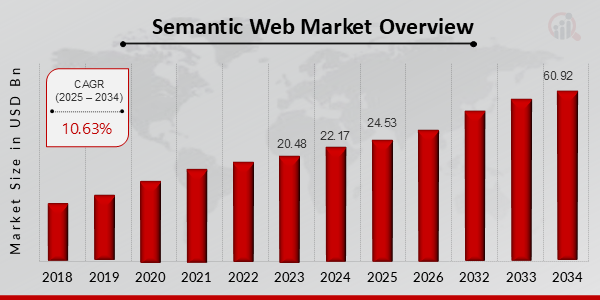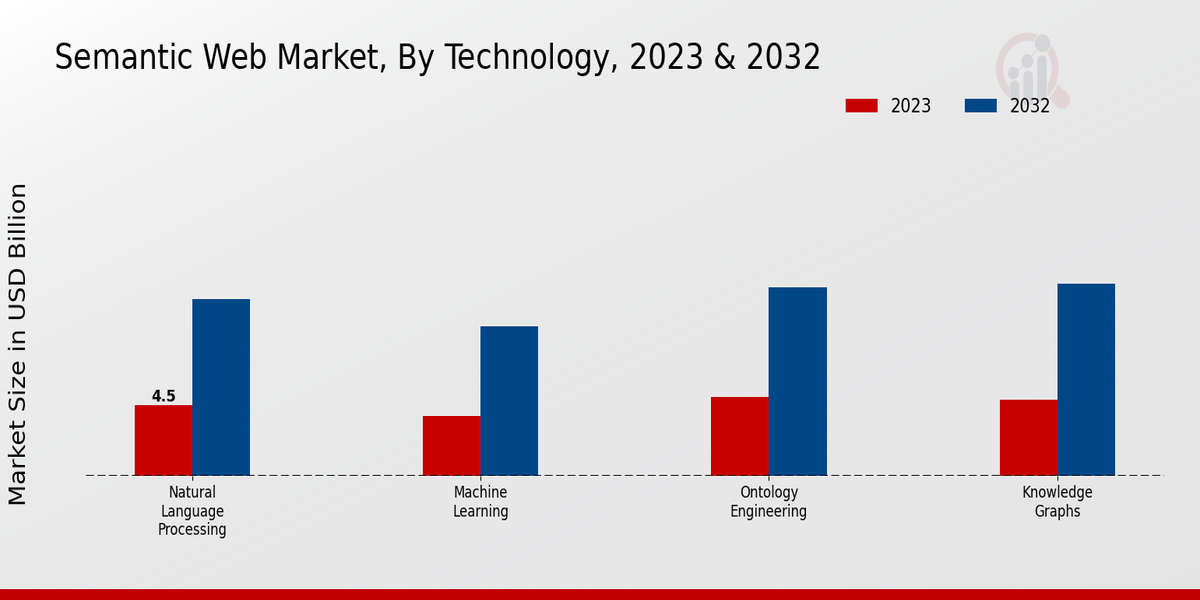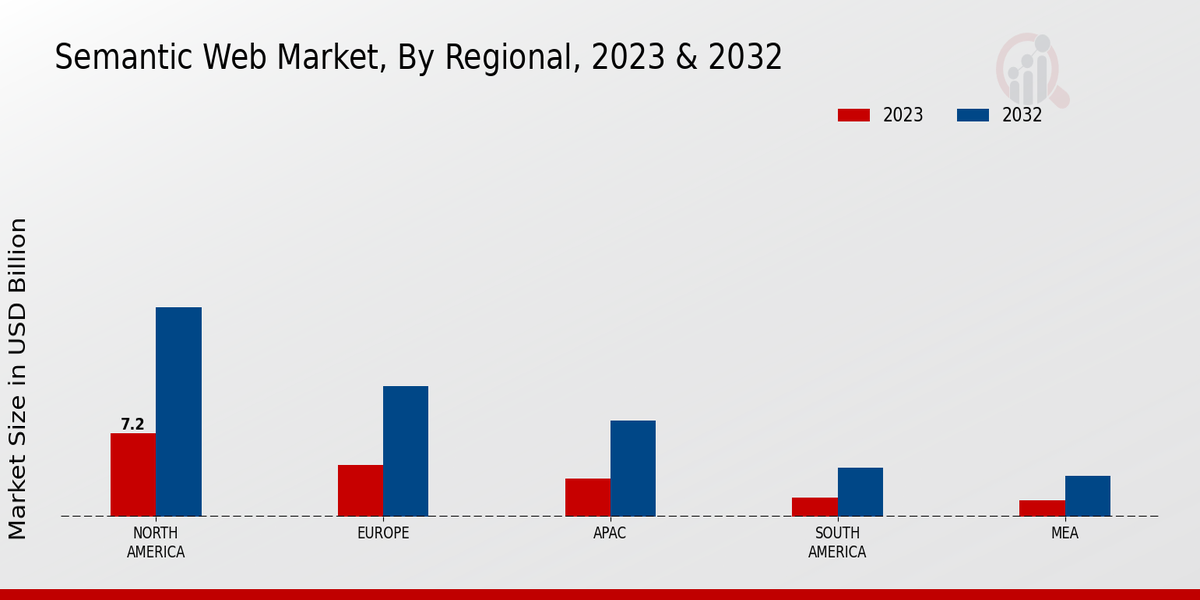Semantic Web Market Overview
Semantic Web Market is projected to grow from USD 24.53 Billion in 2025 to USD 60.92 Billion by 2034, exhibiting a compound annual growth rate (CAGR) of 10.63% during the forecast period (2025 - 2034). Additionally, the market size for Semantic Web Market was valued at USD 22.17 billion in 2024.
Key Semantic Web Market Trends Highlighted
The Semantic Web Market is driven by several key factors. The increasing volume of online data and the need for enhanced data connectivity are pushing businesses to adopt semantic technologies. As organizations seek to improve their data management and retrieval processes, semantic web technologies are becoming essential for enabling better interoperability between diverse data sources. The rise of machine learning and artificial intelligence is also propelling the demand for semantic web solutions, as these technologies rely heavily on structured data for effective learning and decision-making.
Opportunities continue to emerge as more industries recognize the benefits of leveraging semantic web technologies.Sectors such as healthcare, finance, and e-commerce are exploring ways to improve data integration and enhance customer experiences through personalized services. With the growing emphasis on data privacy and the need for compliance with regulations, companies are looking for advanced semantic solutions that can facilitate secure data handling. The expansion of the Internet of Things (IoT) presents another promising avenue, as connected devices generate vast amounts of data that require semantic interpretation for optimal functioning.
Recent trends indicate a shift towards more user-friendly semantic web tools aimed at making technology accessible to a wider audience.Open-source platforms and collaborative development models are gaining traction, allowing for innovation and the rapid evolution of semantic web technologies. Furthermore, the adoption of cloud-based solutions is simplifying deployment and accessibility, making it easier for businesses to implement these technologies without extensive infrastructure investments. As the market evolves, the integration of semantic web principles into existing frameworks is expected to enhance overall efficiency, providing a clear pathway for future developments in this domain.
Figure 1 Semantic Web Market Overview (2025-2034)

Source: Primary Research, Secondary Research, MRFR Database and Analyst Review
Semantic Web Market Drivers
Increase in Demand for Data Interoperability
The Semantic Web Market Industry is witnessing a significant surge in demand for data interoperability among various applications and systems. As organizations accumulate vast amounts of data, the need to connect disparate data sources becomes critical. Semantic web technologies facilitate this connection by allowing data to be understood by machines in a more human-like manner, thus enhancing cooperation between non-homogeneous systems. Furthermore, as enterprises seek to leverage big data and derive meaningful insights, the ability to integrate data from various domains is essential.This trend is catalyzing investments in semantic web technologies as businesses aim to improve their operational efficiencies, optimize decision-making processes, and enhance customer experiences.
With an increasing focus on digital transformations across sectors, the demand for solutions that enable seamless data sharing and improve collaboration is expected to escalate, positioning the Semantic Web Market for sustained growth in the coming years.Likewise, organizations are aiming to harness the power of linked data and semantic technologies to overcome challenges associated with data silos and achieve a unified view of information that supports strategic initiatives. As a result, this increasing need for data interoperability is a significant driver of growth in the global market.
Growing Adoption of Artificial Intelligence
The growing adoption of artificial intelligence (AI) technologies is a key driver for the Semantic Web Market Industry. AI systems rely heavily on structured data for training and improving their algorithms. The Semantic Web enhances data structure by providing a framework for creating machine-readable data, facilitating better machine learning and AI advancements. As organizations increasingly incorporate AI capabilities, they require robust semantic frameworks to ensure that their AI applications can efficiently process and understand data.This dependency on semantic technologies is prompting businesses to invest in solutions that improve data annotation, categorization, and retrieval, supporting AI's function to generate accurate insights and automate processes.
Rising Importance of Enhanced User Experiences
Another significant driver in the Semantic Web Market Industry is the rising importance of enhanced user experiences across digital platforms. Companies are increasingly focused on relationship management and customer satisfaction, leading them to seek out technologies that facilitate personalized interactions. Semantic web technologies allow for advanced personalization by understanding user preferences and behaviors. By leveraging semantic data, organizations can deliver more relevant content, tailored recommendations, and focused marketing strategies. This user-centric focus is prompting investments in semantic tools, which is driving the growth of the market.
Semantic Web Market Segment Insights
Semantic Web Market Technology Insights
The Semantic Web Market is experiencing notable growth within the Technology segment, projected to reach a market valuation of 18.12 USD Billion in 2023 and aiming for an impressive 45.0 USD Billion by 2032. This significant expansion is driven by the rapid advancements in various technologies and their integration into everyday applications, enhancing data management, processing, and connectivity. Major aspects such as Natural Language Processing (NLP), Machine Learning (ML), Ontology Engineering, and Knowledge Graphs constitute essential components of this market.Among these, Natural Language Processing accounted for a market value of 4.5 USD Billion in 2023 and is expected to rise to 11.25 USD Billion by 2032.
The ability of NLP to interpret and manipulate human language makes it crucial for developing applications like chatbots and voice-activated assistants, which are increasingly prevalent in consumer and enterprise settings. Machine Learning follows closely with a valuation of 3.8 USD Billion in 2023, projected to escalate to 9.5 USD Billion by 2032. Its significance stems from the need for intelligent systems that learn from data to enhance predictions and automate processes across various sectors.Ontology Engineering is also a key aspect of the Semantic Web Market, beginning with a valuation of 5.0 USD Billion in 2023 and expected to grow to 12.0 USD Billion by 2032.
As organizations recognize the importance of structured data, Ontology Engineering helps in creating a shared framework for data interpretation, fostering better communication between systems. Meanwhile, Knowledge Graphs, valued at 4.82 USD Billion in 2023 and anticipated to reach 12.25 USD Billion by 2032, play a vital role in connecting disparate data points and enriching the understanding of relationships, which is essential for applications in search engines and recommendation systems.
This diverse segmentation reflects the growing integration of Semantic Web technologies in various industries, revealing a landscape that is not only rich in opportunities but also faces challenges such as data privacy and interoperability standards. As organizations continue to harness the power of semantic technologies, the market is set for robust growth, fostering innovation and improved decision-making across sectors. The insights provided by Semantic Web Market data and statistics underscore the pivotal role that these technologies will play in shaping the future of digital interactions.
Figure 2 Semantic Web Market Type Insights (2023-2032)

Source: Primary Research, Secondary Research, MRFR Database and Analyst Review
Semantic Web Market Application Insights
The Semantic Web Market revenue within the Application segment is showing substantial growth and is valued at 18.12 USD Billion in 2023. By 2032, this value is projected to reach 45.0 USD Billion, reflecting a promising growth trajectory. The market growth is significantly driven by technology advancements and an increasing demand for enhanced data handling capabilities. Specifically, Data Integration stands out for its ability to bring together disparate data sources, enabling businesses to derive actionable insights. Information Retrieval is also critical, allowing users to easily access relevant data from vast information landscapes.
Content Management plays a vital role in maintaining the organization and accessibility of digital content. Furthermore, Recommendation Systems have become essential as they enhance user experience by personalizing content delivery, leading to increased user engagement. Collectively, these areas not only contribute to the Semantic Web Market segmentation but also underscore the industry’s focus on improving data-driven decision-making processes. The ongoing evolution within these applications aligns well with current market demands, paving the way for future opportunities and advancements in the realm of semantic web technologies.
Semantic Web Market End Use Insights
The Semantic Web Market revenue reflects a rapidly evolving landscape with significant growth potential across various end-use sectors. By 2023, the market will be valued at 18.12 billion USD, indicating a robust foundation for future expansion. Within this segmentation, the healthcare sector plays a critical role, leveraging semantic technologies to improve patient care and data interoperability. Similarly, the finance sector significantly dominates, utilizing semantic web solutions to enhance decision-making processes, risk management, and compliance.Telecommunications also benefit from these technologies, as they facilitate improved service delivery and customer engagement through structured and interconnected data.
Education is another key area where semantic web applications are transforming learning modalities by providing personalized content and enhancing research methodologies. Together, these sectors illustrate the varied applications and the relevance of semantic web technologies, driving overall market growth and contributing to the comprehensive Semantic Web Market statistics.The anticipated changes and advancements within these sectors continue to present both challenges and opportunities for stakeholders, reinforcing the importance of understanding market dynamics for strategic planning.
Semantic Web Market Deployment Model Insights
The Semantic Web Market revenue for 2023 was determined to be valued at 18.12 USD Billion, reflecting a growing interest in innovative web technologies. The Deployment Model plays a crucial role in this market, characterized by distinct approaches such as On-Premises, Cloud-Based, and Hybrid solutions. Cloud-based deployments are gaining traction due to their ease of scalability and cost-effectiveness, catering effectively to various business sizes. On-Premises solutions, while demanding higher upfront investments, offer organizations robust security and control over their data, making them a preferred choice for sectors with strict compliance requirements.
Hybrid deployment models are also significant as they combine the best of both worlds, providing versatility for companies to balance their workloads seamlessly. As the Semantic Web Market segmentation continues to evolve, these models address the diverse needs of industries, ensuring alignment with emerging trends and technological advancements. Overall, the intricate balance among these deployment strategies is pivotal for the ongoing growth within the Semantic Web Market industry, further supported by innovative advancements and increasing adoption of semantic technologies.
Semantic Web Market Regional Insights
The Semantic Web Market is experiencing robust growth across various regions, with a total market value expected to reach 18.12 USD Billion in 2023. North America remains a dominant force in the market, holding a substantial share valued at 7.2 USD Billion in 2023, and is projected to rise to 18.0 USD Billion by 2032, thereby showcasing its significant presence and driving innovation in the industry. Europe follows closely with a valuation of 4.5 USD Billion in 2023, anticipated to grow to 11.25 USD Billion by 2032, indicating a strong interest in semantic technologies.APAC captures a critical position with a current market valuation of 3.3 USD Billion, expected to reach 8.25 USD Billion, highlighting the increasing adoption of advanced technologies in the region.
South America and MEA account for smaller market segments, valued at 1.7 USD Billion and 1.42 USD Billion in 2023, respectively, but show potential for growth with projections of 4.25 USD Billion and 3.5 USD Billion by 2032. The diverse market growth in these regions is driven by increasing demand for data interoperability and enhanced AI capabilities, presenting ample opportunities alongside challenges like data privacy and integration complexities. Overall, the Semantic Web Market data reflects a dynamic shift towards digitization, indicating a promising future across various regional markets.
Figure 3 Semantic Web Market Regional Insights (2023-2032)

Source: Primary Research, Secondary Research, MRFR Database and Analyst Review
Semantic Web Market Key Players and Competitive Insights
The Semantic Web Market is characterized by rapid advancements and increasing adoption of technologies that enhance data interconnectivity, interoperability, and machine understanding. This market is shaping the way organizations perceive and utilize structured and unstructured data, enabling them to derive insights and make informed decisions. Various players are entering this space, focusing on the development of frameworks and tools that facilitate the integration of semantic technologies across diverse industries, including healthcare, finance, retail, and telecommunications. The competitive landscape is evolving, marked by strategic partnerships, mergers, and technological innovations aimed at gaining a foothold and offering comprehensive solutions.
Companies are actively enhancing their capabilities to meet the rising demand for richer user experiences and more efficient data processing, driving competition further within this market.Microsoft has positioned itself prominently within the Semantic Web Market, leveraging its extensive technological infrastructure and cloud-based solutions to enhance semantic capabilities. The company benefits from a robust ecosystem that includes various tools and platforms designed to streamline data management and transform raw data into meaningful insights. With significant investments in artificial intelligence and machine learning, Microsoft offers solutions that integrate seamlessly with its existing platforms, enhancing data connectivity and enabling users to harness semantic technologies effectively.
Furthermore, Microsoft’s established reputation in enterprise solutions and its commitment to ongoing innovation allows it to maintain a competitive edge, driving adoption among a diverse client base that demands robust and scalable semantic web solutions.Oracle also holds a significant position in the Semantic Web Market, focusing on delivering comprehensive and integrated data management solutions that facilitate knowledge representation and sharing. The company offers advanced technologies that leverage semantics to improve data accessibility and enhance decision-making processes.
Oracle's strengths in enterprise database management systems and cloud services enable it to provide powerful tools for organizations looking to implement semantic web technologies effectively. With a commitment to research and development, Oracle continuously enhances its offerings to adapt to the evolving needs of its customers, allowing businesses to gain deeper insights from their data ecosystems. This strategic focus on semantic capabilities positions Oracle as a formidable player, fostering strong partnerships and collaborations that further solidify its presence in the market.
Key Companies in the Semantic Web Market Include
- Microsoft
- Oracle
- Zemanta
- Syntags
- IBM
- Semantic Web Company
- OpenLink Software
- Google
- Fluid Operations
- TopQuadrant
- RDF Technologies
- CognitiveScale
- Facebook
- Amazon
Semantic Web Market Industry Developments
Recent developments in the Semantic Web Market have been notably dynamic, with several key players actively enhancing their technological capabilities. Microsoft has focused on integrating semantic web technologies into its cloud services, significantly benefiting data interoperability. Oracle is leveraging semantic web technologies within enterprise applications, fostering a more intelligent application ecosystem. Meanwhile, Google is advancing its knowledge graph to enrich search results, showcasing the impact of semantic web technologies on enhancing user experience.
Companies like IBM and CognitiveScale continue to innovate in AI-driven semantic solutions for enterprise data management. Merger and acquisition activity has been relatively stable, with no significant recent M&A announcements involving the primary players such as Amazon, Facebook, or OpenLink Software. However, the overall market valuation for semantic web technologies is on an upward trajectory, driven by increased demand across industries for data integration solutions and enhanced understanding through AI. This growth indicates a rising recognition of the inherent value in semantic technologies to improve data analytics, foster better relationships with customers, and enable more effective data governance strategies across organizations.
Semantic Web Market Segmentation Insights
-
Semantic Web Market Technology Outlook
- Natural Language Processing
- Machine Learning
- Ontology Engineering
- Knowledge Graphs
-
Semantic Web Market Application Outlook
- Data Integration
- Information Retrieval
- Content Management
- Recommendation Systems
-
Semantic Web Market End Use Outlook
- Healthcare
- Finance
- Telecommunications
- Education
-
Semantic Web Market Deployment Model Outlook
- On-Premises
- Cloud-Based
- Hybrid
-
Semantic Web Market Regional Outlook
- North America
- Europe
- South America
- Asia Pacific
- Middle East and Africa
Semantic Web Market Report Scope
|
Report Attribute/Metric
|
Details
|
|
Market Size 2024
|
22.17 (USD Billion)
|
|
Market Size 2025
|
24.53 (USD Billion)
|
|
Market Size 2034
|
60.92 (USD Billion)
|
|
Compound Annual Growth Rate (CAGR)
|
10.63% (2025 - 2034)
|
|
Report Coverage
|
Revenue Forecast, Competitive Landscape, Growth Factors, and Trends
|
|
Base Year
|
2024
|
|
Market Forecast Period
|
2025 - 2034
|
|
Historical Data
|
2019 - 2023
|
|
Market Forecast Units
|
USD Billion
|
|
Key Companies Profiled
|
Microsoft, Oracle, Zemanta, Syntags, IBM, Semantic Web Company, OpenLink Software, Google, Fluid Operations, TopQuadrant, RDF Technologies, CognitiveScale, Facebook, Amazon
|
|
Segments Covered
|
Technology, Application, End Use, Deployment Model, Regional
|
|
Key Market Opportunities
|
Increased demand for data interoperability, Growth in AI and machine learning, Rising need for enhanced data analytics, Expansion of IoT applications, and Advancements in natural language processing.
|
|
Key Market Dynamics
|
Increased data integration demand, Growth in AI technologies, Rise in data privacy regulations, Need for interoperability standards, and Expansion of IoT applications.
|
|
Countries Covered
|
North America, Europe, APAC, South America, MEA
|
Frequently Asked Questions (FAQ) :
The Semantic Web Market is expected to be valued at 60.92 USD Billion by the year 2034.
The Semantic Web Market is expected to grow at a CAGR of 10.63% from 2025 to 2034.
North America holds the largest market share, with a value of 60.92 USD Billion expected by 2034.
The Natural Language Processing segment is projected to reach a market size of 60.92 USD Billion by 2034.
Key players in the Semantic Web Market include Microsoft, Oracle, Google, IBM, and Amazon.
The Machine Learning technology segment is expected to be valued at 60.92 USD Billion by 2034.
The APAC region is expected to witness significant growth from 2025 to 2034, reaching 60.92 USD Billion by 2034.
The Ontology Engineering segment is expected to reach a market size of 60.92 USD Billion by 2034.
The Knowledge Graphs sector is projected to be valued at 60.92 USD Billion by 2034.
The Semantic Web Market faces challenges related to data integration and privacy while presenting opportunities in enhanced data interoperability and AI applications.





























